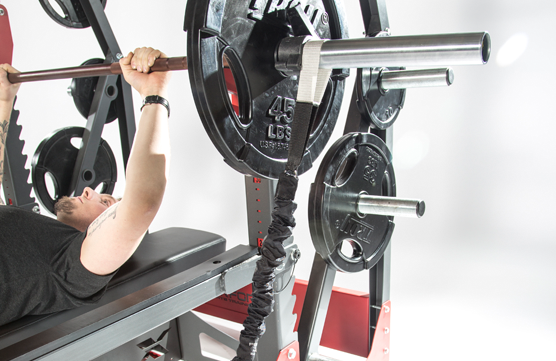FOCUS ON RESEARCH: Variable Resistance Training improves Upper Body Strength & Power

FOCUS ON RESEARCH: Variable Resistance Training improves Upper Body Strength & Power
The bench press is the cornerstone exercise for developing upper body strength and power, especially for sports that include contact such as football, rugby and wrestling.
As athletes get stronger, it is common to reach a plateau in 1RM bench press. This is often experienced in the ‘‘sticking point’’ region as they ascend during the bottom position of the lift. One way to overcome the sticking point and increase strength is by incorporating elastic bands. This type of training method is referred to as variable resistance training.
In this blog, we continue our series Focus on Research by summarizing the following paper:
Variable Resistance Training Promotes Greater Strength and Power Adaptations Than Traditional Resistance Training in Elite Youth Rugby League Players M Rivière, L Louit, A Strokosch, and LB Seitz. Journal of Strength and Conditioning Research Volume 31(4):pages 947-955, 2017
Why the study conducted
The purpose of this study was to examine the strength, velocity, and power adaptations in response to a 6-week program of either variable resistance training (VRT) or traditional free-weight resistance training.
Research participants
- 16 elite rugby league players from the academy team of the Catalans Dragons rugby league club
- Age: 17-19 years old
- Height: 5’11” ± 3 inches
- Weight: 183 ± 24 lbs
- Bench press 1RM: 222 ± 40 lbs
- Bench press 1RM to body mass ratio: 1.2
How the study was conducted
- Players were assigned to a VRT (8 athletes) or traditional strength training group (8 athletes)
- Athletes completed 2 weekly upper- and lower-body training sessions for 6 weeks – 1 day focusing on strength and the other on power
- Training programs were identical except that the VRT group trained the bench press exercise with 20% of the average prescribed load coming from elastic bands (5% at the bottom position and 37% of 1RM at top position of the bench press).
- Bench Press consisted of 3 sets of 2-4 repetitions @82-92% 1RM on the strength day and 3-6 sets of 2 repetitions at 70-82% 1RM on the power day
Key measurements taken before and after the training intervention
- Bench press 1RM (Absolute and Relative to body mass)
- Bench press mean velocity and power at 35, 45, 65, 75, and 85% of 1RM
Results
- The VRT group experienced larger increases in both absolute and relative bench press 1RM.
- Absolute bench press increased by 5.2% in VRT (before = 210 lbs; after = 221 lbs) and by 4.7% in Traditional (pre = 232lbs; before = 243lbs)
- Relative bench press strength (1RM bench press / body weight) increased by 5.9% in VRT and by 3.9% in Traditional
- Both groups experienced large gains in both velocity and power in the heavier loads but small improvements in the lighter loads.
- The improvements in both velocity and power against the heavier loads were larger for the VRT group, whereas smaller differences existed between the 2 groups in the lighter loads.
Conclusion
Variable resistance training using elastic bands may offer a greater training stimulus than traditional free-weight resistance training to improve upper-body strength, velocity, and power in elite youth rugby league players.
Practical applications
- Because VRT improves strength, velocity, and power to a greater extent than traditional strength training, it may also be of interest to use this training method when an athlete reaches the plateau that commonly occurs in strength and power performance.
- To optimize the benefits of a VRT program, it is essential to individualize the training program and correctly assess the resistance provided by the bands for each individual.
- VRT can be implemented into a within-week loading pattern. For example, if using 2 whole-body sessions per week, the first session could target maximum strength and the second session focus on power production.
- VRT may be a useful supplement to bring variety and a different training stimulus into the training program and hence increase athlete motivation and interest in workouts.
Related Perform-X blogs
Using Variable Resistance for the Bench Press